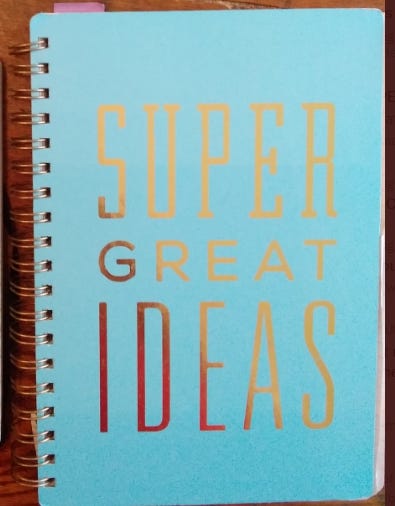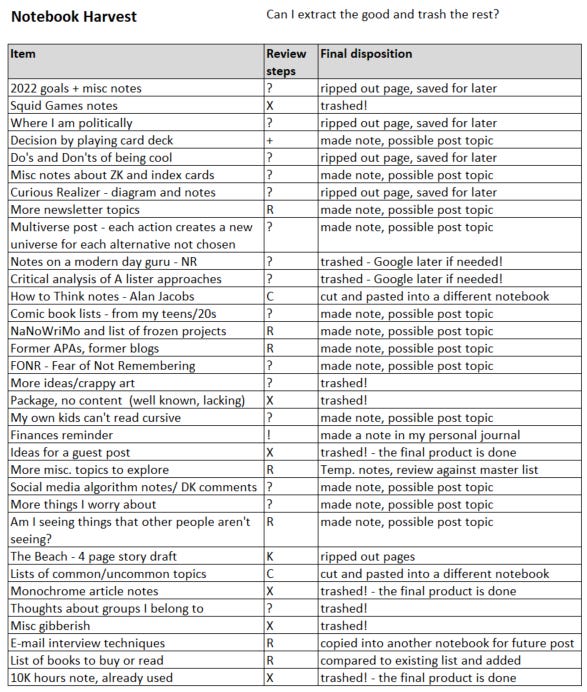Curious Realizer - A Notebook Harvest
Do you keep your old notebooks or do you harvest the good and trash the rest?
I love writing in notebooks, reading notebooks and collecting them. If you’ve been reading this newsletter for any amount of time you know that I’m pro paper.
What you might not realize is that I also enjoy notebook downsizing, so to speak. If I have a 200 page notebook and 180 pages are filled with low value scrawlings and rough drafts, do I really need to hang on to the whole notebook? I’ve been informally using a method to evaluate what I’ve captured in writing and I’m sharing with you today.
You see, I get an itchy feeling when I’m nearing the end of a notebook, especially when I know I’ve got a fresh one waiting to be used (and at this point I’ve got several notebooks waiting in the wings - really nice ones). I get the urge to use up all of the pages. Sometimes I just put a few words on the page with the well-intentioned idea of returning later to add more details to speed up the process. Then I’m left with a decision: do I keep the notebook as is… or do I harvest it?
A notebook harvest, as I think of it, is when you review a notebook and determine whether the contents should be kept. If the majority1 of the material in the notebook isn’t worth keeping then the notebook itself should be harvested: keep the good stuff, recycle or garbage the remainder.
Some of you may recall the Curious Notebook Expo post I published a couple of months ago. Notebook #6 was a scratching and rough drafts book that I received as a gift.
While I appreciated the gift I’m not fond of coil bound notebooks and so #6 was a prime candidate for a notebook harvest.
To give you an idea of the thought process behind a notebook harvest, I created the following categories to evaluate the contents of a notebook, along with a simple one character code to evaluate it.
Seven different outcomes may be a bit much but they work for a quick scan of the material in a notebook:
The ? symbol is just a way to delay making a decision. I may just rip out a page and store it somewhere for future consideration. Or not, I’m not ready to decide yet.
X is for the easy decisions, usually just some stream of consciousness writing or an early draft of a piece that’s completed. Into the recycling bin it goes!
But if I want to keep something, I have to decide whether I’m going to do a C (a simple cut and paste an entire entry into a new notebook (which can be tricky if there’s text on the other side of a page that I want to preserve))
Or do I want to just preserve the essence in a short summary that I can expand upon again at some future date (a +)?
Is it possible that I’ve already captured the thought elsewhere? In my case, yes, I may have already written this down somewhere else so it’s an R and I need to verify whether the information is already captured or if I can add it to an existing entry.
K is for when I want to immediately transpose the thought into electronic format (like a newsletter post, for example)
Sometimes I capture something in writing which has nothing to do with my creative work but it’s important (i.e. an upcoming appointment or bill payment). Those are ! entries.
With this in mind, I used a simple table to review the remaining contents of Notebook #6, as I’ve summarized below. I list the item’s title, one of the seven codes that I described above, and then a third column to indicate what I finally did.
To summarize by type of entry, out of 33 rows:
15 were marked ? needing further consideration
7 were marked R where I needed to compare what I already had for notes
6 were marked X meaning that it was easy to decide to get rid of them
2 were easy cut and paste decisions to preserve the writing somewhere else: I used scissors to remove the items I wanted to keep and I used Scotch tape2 to transplant the material into another notebook
the remaining three items fell into the other categories
And of the 15 items marked with a ?:
7 were recaptured in another notebook for future use
4 items were simply removed from notebook #6 and saved for future consideration
4 items were trashed, they weren’t worth saving
Here are a few thoughts about notebook harvesting:
This is not an efficient process. It takes time and effort to recopying notes and moving things around. Having said that, it’s actually very similar to the monthly review process in the Bullet Journaling method where you build your new monthly plans by reviewing previous months, figuring out what needs to be carried forward and re-transcribing notes where needed.
But even though it’s not an efficient process it’s a useful process. Even though I use 10 notebooks at one time (to be honest, it’s more than 10 but I’ll revisit that topic at some future point), I don’t see the point in keeping prior work unless it has lasting value. Most of the scribbling I put in notebooks isn’t worth keeping unless it has important details to be reused or reconsidered later on. But it’s not always a decision I should make in the moment - time away from a piece helps me to decide if it has lasting value3.
This process would absolutely be more efficient if it was 100% digital. But for me, one of my biggest problems with using digital files for my creative work is that I tend to forget about digital documents: out of sight, out of mind. If I have a physical artefact to hold and review, I’m probably going to read it with more care and attention.
I find this process to be both engaging and relaxing - it’s a nice change from the 95% digital work I do in my day job. It could be my form of handmind.
I’m not aware of many (or any) other people doing something this elaborate but I’m sure there are some folks who will occasionally trash old notebooks and salvage the good stuff. Maybe this provides a better method?
I’m sure that someone in academia has already studied this, I haven’t researched this to see if other writers do something similar. My limited knowledge suggests that many writers will simply hoard old drafts and notes. Breaking news: Jillian Hess’s post on Walter Benjamin is a terrific example of a writer and thinker who took old notes, categorized them and repurposed them for new work.
Over to you, H.A.T.T.E.R.s. Do you keep old notes, rough drafts and previous versions of your work? Do you trash old pages regularly? Or do you live with mountains of paper, clippings or notebooks? Do you have boxes and filing cabinets full of envelopes and manila folders? Or are you a 100% digital creator? Please share your thoughts in the comments!
There is no firm rule about this - it’s more of a guideline.
Sometimes it’s called invisible tape. I don’t like using the shiny tape, I prefer the tape that looks whitish on the role but you can make it transparent by rubbing on it.
Though some doggerel deserve a quick death.








Thanks for a(nother) glimpse into your note taking world, Mark! I don’t harvest my notebooks, and I have a collection that dates back to 1987. A neighbor once asked why I save them all. Great question. And your post here has me wondering the same. There’s probably a lot that could be trashed, but I dunno--I sort of like looking back and seeing that grocery list I made 8 years ago or the name and number O jotted down. Weird, I know.
Wow, this seems like a useful process! A fun and interesting read.
I’m a mostly digital creator, I would say, but I do write story notes/ideas in a notebook. I try to have a notebook on hand most places I go, especially work. If I don’t type a story note into my “notes” on my phone, I jot it down in my notebook. I have 2-3 filled notebooks from the past year or two. Everything I consider useful finds its way onto my laptop sooner or later.